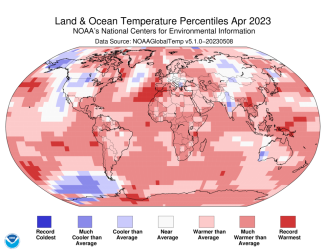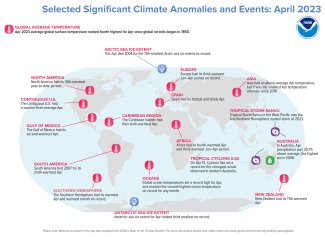Global ocean temperature sets record high for April; Earth had its fourth-warmest April

April Highlights:
- The Southern Hemisphere had its warmest April and warmest month on record.
- As ocean temperatures set a record high for the month of April, NOAA's Climate Prediction Center announced an El Niño Watch alert status.
- April 2023 saw the third-smallest global April sea ice extent on record.
- Cyclone Ilsa set a record for the strongest winds observed in western Australia before making landfall in a sparsely populated area of northwestern Australia.
Globally, April 2023 was the fourth-warmest April in the 174-year NOAA record. The year-to-date (January–April) global surface temperature also ranked fourth warmest on record. According to NCEI’s Global Annual Temperature Outlook, it is virtually certain (>99.0%) that the year 2023 will rank among the 10-warmest years on record and a ~93% chance it will rank among the top five.
This monthly summary, developed by scientists at NOAA’s National Centers for Environmental Information, is part of the suite of climate services NOAA provides to government, business, academia and the public to support informed decision-making.
Monthly Global Temperature
The April global surface temperature was 1.80°F (1.00°C) above the 20th-century average of 56.7°F (13.7°C). Last month ranked as the fourth-warmest April in the 174-year record. April 2023 marked the 49th-consecutive April and the 530th-consecutive month with temperatures at least nominally above the 20th-century average.
Global ocean temperatures set a record high for April at 1.55°F (0.86°C) above the long-term average. This marked the second-highest monthly ocean temperature for any month on record, just 0.02°F (0.01°C) shy of the record-warm ocean temperatures set in January 2016. On April 13, NOAA's Climate Prediction Center announced an El Niño Watch alert status, as ENSO-neutral conditions are expected to last through the Northern Hemisphere spring with a 62% chance of El Niño developing May–July 2023.
The Southern Hemisphere experienced its warmest April and warmest month on record. The April 2023 temperature surpassed that of the previous record-warm month in the Southern Hemisphere, March 2016, by 0.10°F (0.06°C). April 2023 marks the first month in the Southern Hemisphere where average temperatures exceeded 0.90°C above the 20th-century average. Meanwhile, the Northern Hemisphere had its ninth-warmest April, although ocean-only temperatures in the Northern Hemisphere tied with 2020 as warmest on record for the month.
Africa had its fourth-warmest April on record, while South America tied 2007 for its ninth-warmest April. Asia had an above-average April temperature, but it was the smallest April temperature anomaly since 2010. North America, Europe and Oceania had an above-average April temperature, but didn’t rank among the top 20 warmest Aprils on record.
Temperatures were above average throughout most of northeastern North America and Greenland, parts of Central and South America, Africa and Antarctica. In addition, above-average temperatures covered parts of western Europe, eastern and western Asia and Oceania. Sea surface temperatures were above average across much of the northern, western and southwestern Pacific, the central and southern Atlantic and the Indian Ocean. Record warm temperatures covered just over 5% of the world’s surface in April.
Temperatures were near to cooler than average across parts of western North America and Alaska, central and eastern Europe, India, central China, central Russia and western Australia. Sea surface temperatures were near to below average over parts of the southeastern and eastern Pacific and the northern Atlantic Ocean. Less than 1% of the world’s surface had a record-cold April.
Sea Ice and Snow Cover
Globally, April 2023 saw the third-smallest April sea ice extent on record.
Arctic sea ice extent in April averaged 5.40 million square miles, which was about 130,000 square miles below the 1991–2020 average. This tied with April 2004 as the 11th-smallest April extent in the 45-year record. Meanwhile, the April 2023 Antarctic sea ice extent ranked third lowest on record at 2.12 million square miles, or about 560,000 square miles below the 1991–2020 average.
According to data from NOAA and analysis by the Rutgers Global Snow Lab, the Northern Hemisphere snow cover extent during April was 130,000 square miles above the 1991–2020 average. This ranks as a near-average Northern Hemisphere snow cover extent for April. Extent was above average in North America and below average across Eurasia.
Global Precipitation
Above-average April precipitation was observed across parts of the eastern and southeastern U.S., northern South America, Italy, central–east Africa, the Arabian peninsula, central and eastern China and eastern Russia. Drier-than-average conditions were present across much of the western and central U.S., southern South America, western Europe (except Italy), northern Africa, eastern Oceania and Southeast Asia.
Global Tropical Cyclones
Across the globe, three named storms occurred in April, which was below the 1991–2020 average. Two of those storms, Herman and Ilsa, both occurred in the Australian region and reached major tropical cyclone strength (≥111 mph). Cyclone Ilsa’s landfall set a new record for the strongest winds observed in western Australia. The global accumulated cyclone energy (ACE: an integrated metric of the strength, frequency, and duration of tropical systems) was below the 1991–2020 average in April. Tropical Storm Sanvu in the West Pacific was the first Northern Hemisphere named storm of 2023. Lack of activity in the other Northern Hemisphere basins has been normal.
For a more complete summary of climate conditions and events, see our April 2023 Global Climate Report or explore our Climate at a Glance Global Time Series.









